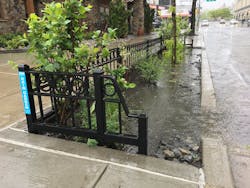NYC doubles size of largest green infrastructure program in nation
NEW YORK, NY, SEPT 9, 2019 -- Mayor de Blasio, DEP Commissioner Vincent Sapienza, partner agencies, elected officials, environmental advocates and community groups recently announced a major expansion of New York City’s nationally recognized Green Infrastructure Program. The City has already begun construction of more than 5,000 specially designed curbside rain gardens in Brooklyn, the Bronx and Queens, building upon the more than 4,000 rain gardens that have already been built. This construction will bring a total of more than 9,000 curbside rain gardens to New York City, helping to prevent flooding and reduce Combined Sewer Overflows into local waterways by more than 500 million gallons each year, thereby further improving the health of New York Harbor and its tributaries.
“We are deploying all of the resources at our disposal to tackle the challenge of global warming head-on,” said Mayor de Blasio. “We are doubling the size of the largest green infrastructure program in the country, creating green oases in our neighborhoods and protecting our waterways for all New Yorkers to enjoy.”
“These major investments in green infrastructure will prevent flooding and make New York City better prepared for climate change,” said Jainey Bavishi, Director of the Mayor’s Office of Resiliency. “Flooding isn’t only a threat in coastal neighborhoods. As global warming ushers in increasingly intense rainstorms, we’re also taking steps to make our inland communities more resilient and more vibrant places to live.”
More than 70 percent of New York City’s land mass is covered by an impervious surface, which creates tremendous volumes of stormwater entering the sewer system during rainstorms. Curbside rain gardens help to soften the city’s landscape and allow the stormwater to be naturally absorbed into the ground, therefore reducing flooding that can impact roadways, homes and businesses. By keeping stormwater out of the City’s combined sewer system, where it can contribute to combined sewer overflows into local waterways, the rain gardens serve as a tool in the City’s ongoing effort to improve the health of local waterways.
In addition, some of the neighborhoods getting these rain gardens currently have less than average street tree counts and higher than average rates of asthma among young people. The increased tree canopy and vegetation created through the addition of the rain gardens will help to improve air quality, provide shade during hot summer months, and beautify the neighborhoods.
DEP has expanded its green infrastructure portfolio to include additional types of installations to be sited in even more locations along streets and sidewalks, such infiltration basins, which have a concrete or grass top depending on the existing sidewalk, rain gardens with pre-treatment devices, and porous pavements.
Increasing green infrastructure is a critical part of New York City’s $20 billion strategy to address the impacts of climate change, including extreme rainfall, rising temperatures, storm surge, and sea-level rise. This strategy includes constructing long-term coastal resiliency projects in all five boroughs, implementing a $106 million strategy to address extreme heat, partnering with utilities to harden critical infrastructure, increasing the resiliency of small businesses, and much more.
These efforts will build a New York City that is better prepared for the impacts of climate change while creating stronger and more equitable communities, better access to the waterfront, and revitalized natural ecosystems.
New York City is also taking aggressive action to reduce the carbon emissions driving climate change and has committed to achieving carbon neutrality by 2050.
